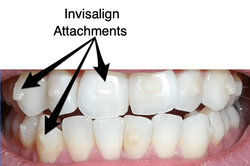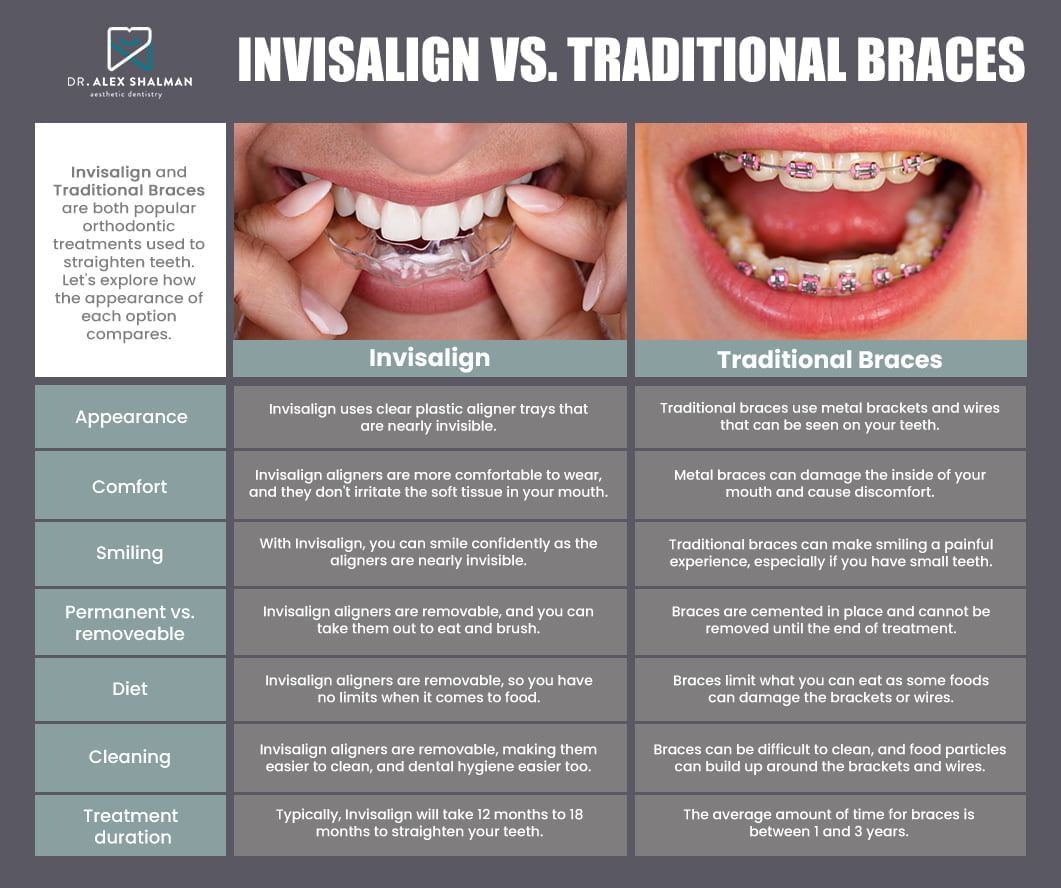Invisalign vs. Standard Braces: Which Option Is Right for You?
When thinking about orthodontic therapy, the selection between Invisalign and standard braces offers numerous important elements that merit cautious analysis. Invisalign offers a discreet option with detachable aligners, while standard dental braces give a more noticeable yet effective solution for severe misalignment. Each option encompasses unique advantages and downsides connected to looks, convenience, therapy period, and cost. Understanding these subtleties is essential for making a notified decision that aligns with your individual choices and way of life. The concern stays: which choice will best meet your orthodontic needs and assumptions?
Summary of Therapy Alternatives

On the other hand, typical braces include steel brackets and cables that are adhered to the teeth. This method applies continual pressure in time to attain alignment. While efficient for intricate orthodontic issues, typical dental braces call for regular sees for changes and can position difficulties in keeping oral health as a result of the trouble of cleaning around wires and braces.
Both options have their values, and the selection typically pivots on particular dental problems, way of living choices, and patient conformity. Inevitably, speaking with an orthodontic expert is vital for determining the most suitable treatment plan tailored to private requirements. Comprehending the nuances of each choice can substantially affect the total success of orthodontic treatment.
Visual Considerations
A considerable aspect influencing the selection between Invisalign and standard dental braces is the visual appeal each treatment uses. Invisalign aligners are crafted from clear plastic, making them essentially unnoticeable when put on. This very discreet appearance is especially appealing to adults and teenagers who might really feel uneasy regarding their orthodontic treatment. The ability to preserve a natural smile throughout the positioning procedure can substantially enhance the patient's self-confidence in expert and social settings.
On the other hand, standard braces include metal braces and wires, which can be extra obvious. While innovations in orthodontic innovation have caused the advancement of smaller sized brackets and tinted elastics, traditional dental braces still maintain a more obvious profile. For some people, the visibility of braces might deter them from looking for necessary treatment.
Ultimately, the option in between Invisalign and typical braces may rest on personal preferences regarding aesthetics. People who focus on discernment typically favor Invisalign, while those who are less worried about exposure might choose standard dental braces. Understanding the aesthetic effects of each option is vital for making an educated decision that aligns with one's way of life and choices.
Convenience and Convenience

In regards to ease, Invisalign aligners are removable, enabling patients to appreciate their preferred foods without restriction and keep ideal oral hygiene. Brushing and flossing are streamlined, as the aligners can be secured during these regimens, whereas standard braces call for mindful steering around cables and brackets.
In addition, Invisalign's modern system enables less orthodontic sees. Individuals normally obtain numerous sets of aligners simultaneously, which can simplify the therapy procedure and minimize time spent in the orthodontist's chair. On the other hand, conventional braces necessitate routine changes, making them less hassle-free for those with busy routines. Invisalign. Generally, the comfort and comfort of Invisalign make it an enticing selection for several people seeking orthodontic therapy.
Therapy Duration and Efficiency
While both Invisalign and conventional dental braces work in fixing dental imbalances, the period of treatment can vary dramatically between both alternatives. Usually, Invisalign therapy can take anywhere from 12 to 18 months, relying on the complexity of the case. The clear aligners work by slowly changing teeth into their desired positions, and normal follow-ups with an orthodontist aid ensure progress continues to be on the right track.
On the other hand, standard braces typically call for a longer dedication, usually varying from 18 months to 3 years. This is because of their page set nature and using cables and brackets, which can be a lot more effective for intricate situations and severe misalignments (Invisalign). The therapy effectiveness of typical braces is well-documented, as they permit specific changes and greater control over tooth movement
Eventually, the selection between Invisalign and traditional dental braces might rest on both the expected therapy period and the details dental problems available. Consulting with an orthodontist is vital, as they can supply customized recommendations based upon specific demands, making sure the selected approach aligns with wanted durations and outcomes.
Expense Comparison and Insurance Coverage Alternatives
Cost plays a substantial duty in the decision-making process for people thinking about orthodontic treatment, whether going with Invisalign or conventional braces. Generally, the cost of Invisalign varieties from $3,000 to $8,000, while typical dental braces normally set you back between $2,000 and $6,000. Factors influencing these expenses consist of the intricacy of the situation, the period of therapy, and geographical location.
Insurance policy insurance coverage can substantially influence out-of-pocket costs. Lots of dental insurance strategies supply partial insurance coverage for orthodontic therapies, yet the specifics can vary widely. It is crucial for patients to assess their insurance coverage policies to figure out the extent of insurance coverage for either choice. Typically, standard braces might be much more regularly covered by insurance coverage plans compared to Invisalign, which some insurers classify as an aesthetic treatment.
In addition, a number of orthodontic methods provide adaptable repayment strategies, making both therapy options more easily accessible. People must ask about prospective funding choices and price cuts for ahead of time payments. Evaluating the complete cost, including insurance advantages and payment strategies, is necessary for making an educated choice that straightens with both visual choices and budget plan considerations.

Verdict
In recap, the selection in between Invisalign and conventional braces pivots on numerous elements, consisting of aesthetic preferences, comfort, therapy period, and cost. Invisalign provides a very discreet, removable option that assists in dental health and dietary flexibility, while typical braces might be better for complicated oral concerns and usually come with a lower price point. Eventually, consultation with an orthodontist is important to examine private situations and determine the most appropriate treatment alternative for achieving ideal oral positioning.
When considering orthodontic treatment, the choice between Invisalign and typical braces offers numerous vital factors that warrant cautious assessment.Contrasting Invisalign and conventional dental braces reveals Discover More Here distinctive therapy alternatives for orthodontic adjustment.While both Invisalign and standard dental braces are reliable in correcting oral imbalances, the duration of treatment can vary considerably between the 2 alternatives.Cost plays a significant function in the decision-making process for individuals thinking about orthodontic therapy, whether deciding for Invisalign or traditional visit our website dental braces.In summary, the choice in between Invisalign and typical braces pivots on numerous elements, consisting of visual choices, convenience, therapy duration, and expense.